Pain That Travels From Joint to Joint
Pain that seems to be coming from joints can sometimes be coming from structures outside the joints, such as ligaments, tendons, or muscles (see Introduction to the Biology of the Musculoskeletal Arrangement Introduction to the Biology of the Musculoskeletal Arrangement The musculoskeletal system provides form, stability, and movement to the homo torso. It consists of the torso's bones (which make up the skeleton), muscles, tendons, ligaments, joints, cartilage... read more ). Examples of such disorders are bursitis Bursitis Bursitis is painful inflammation of a bursa (a flat, fluid-filled sac that provides cushioning where skin, muscles, tendons, and ligaments rub over bones). Movement is usually painful, and bursae... read more 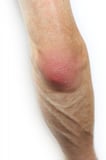 and tendinitis Tendinitis and Tenosynovitis Tendinitis is inflammation of a tendon. Tenosynovitis is tendinitis accompanied by inflammation of the protective covering around the tendon (tendon sheath). The cause is not e'er known. Tendons... read more .
and tendinitis Tendinitis and Tenosynovitis Tendinitis is inflammation of a tendon. Tenosynovitis is tendinitis accompanied by inflammation of the protective covering around the tendon (tendon sheath). The cause is not e'er known. Tendons... read more .
True articulation hurting (arthralgia) may or non be accompanied by joint inflammation (arthritis). The most common symptom of joint inflammation is hurting. Inflamed joints may also exist warm and swollen, and less often the overlying skin may be red. Arthritis may involve just joints of the limbs or likewise joints of the central part of the skeleton, such every bit the spine or pelvis. Pain may occur merely when a joint is moved or may be nowadays at rest. Other symptoms, such every bit rash, fever, eye pain, or mouth sores, may be nowadays depending on the cause of the articulation pain.
In well-nigh cases, the cause of pain originating within multiple joints is arthritis. Disorders that crusade arthritis may differ from each other in certain tendencies, such as the following:
-
How many and which joints they commonly involve
-
Whether the central part of the skeleton, such as the spine or pelvis, is typically involved
-
Whether arthritis is sudden (acute) or longstanding (chronic)
Acute arthritis affecting multiple joints is most oftentimes due to
-
Viral infection
Less common causes of acute arthritis in multiple joints include Lyme disease Lyme Disease Lyme disease is a tick-transmitted infection acquired by Borrelia species, primarily past Borrelia burgdorferi and sometimes past Borrelia mayonii in the United States. These... read more  (which as well may touch but 1 articulation), gonorrhea Gonorrhea Gonorrhea is a sexually transmitted infection caused by the leaner Neisseria gonorrhoeae, which infect the lining of the urethra, cervix, rectum, and throat or the membranes that cover... read more
(which as well may touch but 1 articulation), gonorrhea Gonorrhea Gonorrhea is a sexually transmitted infection caused by the leaner Neisseria gonorrhoeae, which infect the lining of the urethra, cervix, rectum, and throat or the membranes that cover... read more 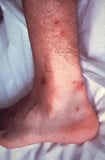 and streptococcal bacterial infections Streptococcal Infections Streptococcal infections are caused by any one of several species of Streptococcus. These gram-positive, sphere-shaped (coccal) bacteria (see figure How Bacteria Shape Up) cause many... read more , reactive arthritis Reactive Arthritis Reactive arthritis (previously called Reiter syndrome) is a spondyloarthritis causing inflammation of the joints and tendon attachments at the joints, often related to an infection. Joint pain... read more than
and streptococcal bacterial infections Streptococcal Infections Streptococcal infections are caused by any one of several species of Streptococcus. These gram-positive, sphere-shaped (coccal) bacteria (see figure How Bacteria Shape Up) cause many... read more , reactive arthritis Reactive Arthritis Reactive arthritis (previously called Reiter syndrome) is a spondyloarthritis causing inflammation of the joints and tendon attachments at the joints, often related to an infection. Joint pain... read more than  (arthritis that develops after an infection of the digestive or urinary tract), and gout Gout Gout is a disorder in which deposits of uric acrid crystals accumulate in the joints considering of high blood levels of uric acid (hyperuricemia). The accumulations of crystals cause flare-ups ... read more
(arthritis that develops after an infection of the digestive or urinary tract), and gout Gout Gout is a disorder in which deposits of uric acrid crystals accumulate in the joints considering of high blood levels of uric acid (hyperuricemia). The accumulations of crystals cause flare-ups ... read more  .
.
Chronic arthritis affecting multiple joints is virtually frequently due to
-
Inflammatory disorders such as rheumatoid arthritis Rheumatoid Arthritis (RA) Rheumatoid arthritis is an inflammatory arthritis in which joints, usually including those of the hands and anxiety, are inflamed, resulting in swelling, hurting, and often destruction of joints.... read more
 , psoriatic arthritis Psoriatic Arthritis Psoriatic arthritis is a spondyloarthritis and a form of articulation inflammation that occurs in some people who have psoriasis of the skin or nails. Joint inflammation can develop in people who take... read more
, psoriatic arthritis Psoriatic Arthritis Psoriatic arthritis is a spondyloarthritis and a form of articulation inflammation that occurs in some people who have psoriasis of the skin or nails. Joint inflammation can develop in people who take... read more 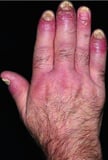 , or systemic lupus erythematosus Systemic Lupus Erythematosus (SLE) Systemic lupus erythematosus is a chronic autoimmune inflammatory connective tissue disorder that can involve joints, kidneys, peel, mucous membranes, and blood vessel walls. Issues in the... read more than
, or systemic lupus erythematosus Systemic Lupus Erythematosus (SLE) Systemic lupus erythematosus is a chronic autoimmune inflammatory connective tissue disorder that can involve joints, kidneys, peel, mucous membranes, and blood vessel walls. Issues in the... read more than 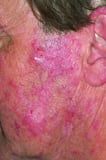 (in adults)
(in adults)
Some chronic inflammatory disorders can affect the spine as well as the limb joints (chosen the peripheral joints). Some affect sure parts of the spine more frequently. For example, ankylosing spondylitis more commonly affects the lower (lumbar) part of the spine, whereas rheumatoid arthritis more typically affects the upper (cervical) role of the spine in the neck.
The most common disorders outside the joints that cause pain effectually the joints are
Bursitis and tendinitis frequently event from injury, unremarkably affecting only one joint. However, certain disorders cause bursitis or tendinitis in many joints.
In evaluating joint hurting, doctors first try to decide whether joint hurting is caused by a disorder of the joints or a serious bodywide (systemic) affliction. Serious bodywide disorders may need specific immediate treatment. The following information can assistance people determine when to come across a doctor and know what to expect during the evaluation.
In people with pain in more than 1 joint, symptoms that should prompt rapid evaluation include
-
Articulation swelling, warmth, and redness
-
New rashes, spots, or purple blotches
-
Sores in the mouth or nose or on the genitals
-
Chest pain, shortness of breath, or new or severe cough
-
Abdominal pain
-
Fever, sweats, weight loss, or chills
-
Centre redness or pain
People with warning signs should see a doctor right away. People without alarm signs should call a medico. The doctor decides how quickly they need to be seen based on the severity and location of hurting, whether joints are swollen, whether the cause has been diagnosed previously, and other factors. Typically, a delay of several days or and then is not harmful for people without warning signs.
Doctors ask about hurting severity, onset (sudden or gradual), how symptoms vary over fourth dimension, and what increases or decreases pain (for example, residue or movement or time of day when the symptoms worsen or allay). They ask about joint stiffness and swelling, previously diagnosed joint disorders, and take chances of exposure to sexually transmitted infections and Lyme disease.
Doctors then do a complete physical examination. They check all joints (including those of the spine) for swelling, redness, warmth, tenderness, and noises that are made when the joints are moved (called crepitus). The joints are moved through their full range of motion, commencement past the person without assistance (called active range of motion) and so past the dr. (chosen passive range of motion). This examination helps determine which structure is causing the hurting and if inflammation is present. They also check the eyes, oral cavity, nose, and genital expanse for sores or other signs of inflammation. The skin is examined for rashes. Lymph nodes are felt and the lungs and middle examined. Doctors normally test function of the nervous system then that they can detect disorders of the muscles or nerves.
Some findings give helpful clues as to the cause. For example, if the tenderness is around the joint but not over the articulation, bursitis or tendinitis is likely the cause. If tenderness is nowadays all over, fibromyalgia is possible. If the spine is tender as well as the joints, possible causes include osteoarthritis, reactive arthritis, ankylosing spondylitis, and psoriatic arthritis. Findings in the hand tin help doctors differentiate between rheumatoid arthritis and osteoarthritis, 2 specially common types of arthritis. For example, rheumatoid arthritis is more than likely to involve the large knuckle joints (those that join the fingers with the hand) and wrist. Osteoarthritis is more than likely to involve the finger joint near the fingernail. The wrist is unlikely to exist afflicted in osteoarthritis, except at the base of the thumb.
The following tests are the most important overall:
-
Tests of joint fluid
-
Blood tests for autoantibodies
-
Erythrocyte sedimentation charge per unit (ESR) and C-reactive poly peptide
The ESR is a test that measures the rate at which scarlet blood cells settle to the lesser of a examination tube containing a blood sample. Blood that settles rapidly typically means that bodywide (systemic) inflammation is probable, but many factors can affect the ESR test including age and anemia, so the examination is sometimes inaccurate. To assist decide whether bodywide inflammation is present, doctors sometimes do another blood exam called C-reactive protein (a poly peptide that circulates in the blood and dramatically increases in level when at that place is inflammation).
The underlying disorder is treated. For example, people with an autoimmune disorder (such every bit systemic lupus erythematosus) may demand a drug that suppresses the allowed system. People with a gonorrhea infection in the articulation need antibiotics.
Osteoarthritis Osteoarthritis (OA) Osteoarthritis is a chronic disorder that causes damage to the cartilage and surrounding tissues and is characterized by pain, stiffness, and loss of role. Arthritis due to damage of joint... read more than 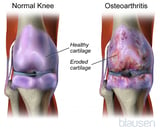 is the well-nigh common cause of multiple joint pains in the elderly. Although more common among younger adults (those aged 30 to forty), rheumatoid arthritis Rheumatoid Arthritis (RA) Rheumatoid arthritis is an inflammatory arthritis in which joints, usually including those of the hands and feet, are inflamed, resulting in swelling, pain, and often destruction of joints.... read more
is the well-nigh common cause of multiple joint pains in the elderly. Although more common among younger adults (those aged 30 to forty), rheumatoid arthritis Rheumatoid Arthritis (RA) Rheumatoid arthritis is an inflammatory arthritis in which joints, usually including those of the hands and feet, are inflamed, resulting in swelling, pain, and often destruction of joints.... read more  can besides begin after in life (subsequently age 60). Older adults who may have rheumatoid arthritis may likewise have cancer. People over age 55 who have hip and shoulder stiffness and pain that is usually worse in the morning may have polymyalgia rheumatica Polymyalgia Rheumatica Polymyalgia rheumatica involves inflammation of the lining of joints, causing severe pain and stiffness in the muscles of the neck, back, shoulders, and hips. The crusade is unknown. The neck... read more . Recognizing polymyalgia rheumatica is of import considering treating it tin can help foreclose other problems. Gout Gout Gout is a disorder in which deposits of uric acid crystals accumulate in the joints because of high blood levels of uric acid (hyperuricemia). The accumulations of crystals cause flare-ups ... read more
can besides begin after in life (subsequently age 60). Older adults who may have rheumatoid arthritis may likewise have cancer. People over age 55 who have hip and shoulder stiffness and pain that is usually worse in the morning may have polymyalgia rheumatica Polymyalgia Rheumatica Polymyalgia rheumatica involves inflammation of the lining of joints, causing severe pain and stiffness in the muscles of the neck, back, shoulders, and hips. The crusade is unknown. The neck... read more . Recognizing polymyalgia rheumatica is of import considering treating it tin can help foreclose other problems. Gout Gout Gout is a disorder in which deposits of uric acid crystals accumulate in the joints because of high blood levels of uric acid (hyperuricemia). The accumulations of crystals cause flare-ups ... read more  in older women tends to affect the distal interphalangeal (DIP) joints of the hands (the first knuckles from the tip of the fingers).
in older women tends to affect the distal interphalangeal (DIP) joints of the hands (the first knuckles from the tip of the fingers).
-
Acute pain in multiple joints is most often due to inflammation, gout, or the beginning or flare up of a chronic joint disorder.
-
Chronic pain in multiple joints is unremarkably due to osteoarthritis or an inflammatory disorder (such equally rheumatoid arthritis) or, in children, juvenile idiopathic arthritis.
-
When significant fluid accumulates inside of a joint, a fluid sample usually must exist withdrawn and tested.
-
Lifelong concrete action helps maintain range of motion in people with chronic arthritis.
0 Response to "Pain That Travels From Joint to Joint"
Post a Comment